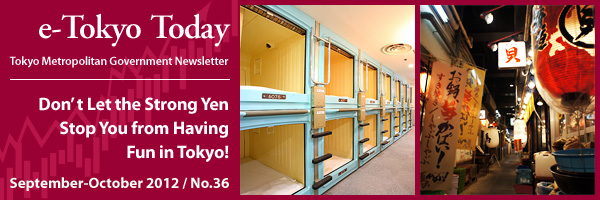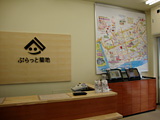
 |
|
News & Announcements |
|||
|
Brand-new Hotel in a Historical Cultural Property: The Tokyo Station Hotel to Open on October 3
 The Tokyo Station Hotel, established in 1915 and temporarily closed from 2006 due to the renovation of Tokyo Station Marunouchi Building, will re-open on October 3, 2012, after all facilities have completed renovation. The Tokyo Station Hotel, established in 1915 and temporarily closed from 2006 due to the renovation of Tokyo Station Marunouchi Building, will re-open on October 3, 2012, after all facilities have completed renovation.What makes the hotel stand out is that it is built in the National Important Cultural Property, Tokyo Station. The renovation was part of the project that has been reconstructing Tokyo Station as it used to be when originally built in 1914. You can't expect more in terms of location. Easy access between the hotel and Haneda / Narita airports, and most of subway lines have a station nearby. The hotel is accepting reservations. The hotel features rooms with high ceilings and tall graceful windows. Guests will be delighted to experience its classic, sophisticated atmosphere and its historical significance. The interior, designed by the remarkable British interior design firm Richmond International Ltd., combines European classicism and modernism to create an elegant and sophisticated space. Tokyo Station Hotel |
|||
|
Travel Japan with Kitty:Japan Tourism Agency launches its application for iPhone!
World's most famous feline character Hello Kitty becomes the tour guide on iPhone, presenting local tourist landmarks. The app covers all 47 prefectures of Japan, featuring 53 Hello Kitty characters in special costume representing each prefecture that provides local tourist information. The app's camera function enables users to insert the Hello Kitty in their photos, and post to social network directly from iPhone. The app is available to download for free on the AppStore by March 31, 2013. Japan Tourism Agency iTunes Store |
|||
|
Fashionable Outdoor Food Court, 246COMMON, Opened in Omotesando
At the back, the Yokocho area are lined with small and old-style houses and create a traditional atmosphere. Visiting will be a good opportunity to enjoy the latest expression of the current Tokyo food culture in a casual manner. 246COMMON (Japanese only) |
|||
|
Tokyo Metropolitan Government Appoints Rie Aoki Tourism Representative in Los Angeles
GOTOKYO: Tourism Representative of the City of Tokyo |
|||
|
Don't Let the Strong Yen Stop You from Having Fun in Tokyo! |
||||||||||||||||||||||||||||||||||||||||||||||||||||||||||||||||||||||||||||||||||||||||||||||
|
Are you like the majority of people who think everything in Japan is expensive?
Japan is definitely not a cheap place to travel as you know, and the current strong yen may make you think traveling to Tokyo as a mission impossible. However, what you may not know is that travelers are actually enjoying getting around Tokyo on a smaller budget. We will guide you with smart and useful tips for traveling in Tokyo. (100 yen= 1.26 dollars, 1.02 euros, 0.80 pounds) Accommodations
Tokyo offers a cornucopia of choices. You will never fail to find an option perfect for your budget.A place to stay? Yes, you will find a good one! There are lots of hotels in Tokyo offering accommodations at reasonable prices. 1. "Business Hotels"
2. Capsule Hotels
Each capsule room has what you need for overnight accommodation, including a set of bedding, TV, radio, and an alarm clock. Prices are lower than those of business hotels, of course, considering the surface area you occupy. Capsule hotels were developed in Japan taking into account land prices and safety factors in the large cities. Now they are getting popular among foreign tourists who want to experience things "uniquely Japanese." Most of the capsule hotels are only for men, but some offer rooms for women, too. Prices are about 3,000 yen to 4,500 yen, depending on the location and day of the week.
Transportation
1. Trains Once your destination is set, check the train fare to get to the place. Here is a list of major one-day train passes that allow you unlimited boarding and re-boarding privileges within a designated area during a designated period. They need to be used a certain number of times to get their worth, but basically the more you use them, the more you save. If you want to get around Tokyo for a whole day, you should get one suitable for your travel plans. http://www.jorudan.co.jp/english/ http://www.hyperdia.com/en/ Major Discount Tickets Child prices are about half of Adult prices.
More interested in taking time for each tour spot rather than zipping around everywhere? Traveling in Tokyo by train is not very expensive compared to doing so in other cities around the world. Doesn't sound believable? The minimum Metro fare is 1.7 euros (167 yen) in Paris, 2.5 dollars (198 yen) in NY, and, a surprising 4.3 pounds (538 yen) in London, while it's only 130 yen for JR and 160 yen for subways in Tokyo. Now you know. 2. Buses
It runs between Kinshicho Station and Ueno Matsuzakaya through TOKYO SKYTREE® and Asakusa Kaminarimon Gate on weekdays, and on Saturdays and Sundays it goes to Nihombashi Mitsukoshi and Tokyo Station via Ueno. The bus comes every 20 minutes, and you can get on it for only 200 yen per boarding, without a reservation. Tokyo Shitamachi Bus Planning to spend a whole day looking around Marunouchi, Nihombashi or Odaiba? Then a free shuttle bus service is perfect for you. Shuttle bus services, called Metrolink Nihombashi (Tokyo Station Yaesu Exit, Nihombashi etc.), Marunouchi Shuttle (Shin Marunouchi Building, Hibiya, etc.), and Tokyo Bay Shuttle (National Museum of Emerging Science and Innovation (Miraikan), VenusFort, DiverCity, Fuji TV, etc.), offer free shuttle buses going around the area every 10 to 20 minutes. Hinomaru Limousine (Japanese only) Public community bus service may be bit confusing, but it's an inexpensive and convenient way to enjoy Tokyo more closely. For example, after shopping in Shibuya, take the #06 metropolitan bus to Shimbashi Station through the Yamanote Area, a rather hilly residential area in the center of Tokyo that includes Hiroo and Azabu-juban. If you haven't been to Tokyo Tower, the bus goes right by it. It's not touristy, but perfect for tourists who want to see everyday life of local people. Service route (Japanese only) Toei bus route map 3. By Bike: Best for flexibility! Completely eco-friendly and flexible, with fresh air! Please read the special article in the July issue introducing recommended bicycle routes and rental cycle shops in Tokyo. e-Tokyo Today July-August 2012 Eating
Tokyo is now almost a synonym for "gourmet city." That's not only because of the world's highest number of Michelin stars the restaurants in the city have been given (it's one of the major reasons, though), but also the sheer number of restaurants, as numerous as the stars! There are about 57,000 restaurants in Tokyo alone, which gives you abundant choices, variety-wise, and yes, price-wise too.Below are some good places to eat for affordable prices, but their food can't be measured by the prices. Satisfaction guaranteed for your stomach and wallet. 1. Yokocho and Railway Underpasses
Yokocho and railway underpasses have always been crowded with small eating establishments, where local people enjoy food and drinks for reasonable prices in a casual atmosphere. The famous ones are Omoide-yokocho (Japanese only) in Shinjuku, Hamonika-yokocho in Kichijoji, and the railway underpass in Shimbashi. The retrospective popularity of the nostalgic feeling permeating such areas promotes the movement of developing new yokocho, such as Yurakucho Sanchoku Inshokugai (Japanese only) and Ebisu-yokocho(Japanese only). Average prices: a jug of beer for 550 yen, a skewer of yakitori for 190 yen, edamame (boiled green soybeans in a pod) for 350 yen, jaga-bata (a potato with butter) for 500 yen 2. B-class Gourmet Food
Tokyo Ramen Street (Japanese only) First Avenue Tokyo Station
The simple ingredients and preparation have made it a popular casual snack among kids in downtown Tokyo. Tsukishima's Monja Street (Japanese only) is famous for having 75 monjayaki restaurants. Average prices range from 700 yen to 1,400 yen. 3. Lunch at Michelin Star Restaurants
Other Tips
Don't forget to use discount coupons attached to "Tokyo Handy Guide" and "Tokyo Handy Map," published by the Tokyo Metropolitan Government. If you are planning to visit any of the listed places such as Hama-rikyu Gardens and Edo Tokyo Museum, make sure to use the coupons. Tokyo Tourist Information Centers 2. Tour Guide Service by Volunteers The Tokyo Tourism Volunteers offer tour guide services to attractive spots in Tokyo in English, Korean, Chinese, German, French, Italian, and Spanish. A half-day tour costs from nothing up to 4,000 yen for a group of 5 or less. There are 10 routes to visit major tourist spots in Tokyo, starting from Shinjuku (Tokyo Tourist Information Center in the Tokyo Metropolitan Government Building). GOTOKYO: Free Guided Tours for Foreign Tourists
Markets are held at various sites in Tokyo on weekends. Food items including fresh local vegetables and fruits are sold at such markets. Negotiating for discounts at flea markets is enjoyable and antique fairs may be especially exciting for you if you are interested in Japan's unique traditional goods. GOTOKYO: Discover x Tokyo Vol. 2 4. Outdoor Activities Despite the stereotypical image of Tokyo as a "concrete jungle," Tokyo is a city full of greenery. On a sunny day, grab something for lunch and go on a picnic in a park! There are many places to buy a nice lunch for a picnic in major parks: the basement of department stores in Ginza and street venders at Tokyo International Forum Plaza for Hibiya Park, the basement of department stores and bakeries in Shibuya for Yoyogi Park, and Ameyoko (Japanese only), where you can buy precut fresh fruit and kebabs, for Ueno Park. Tokyo Metropolitan Park Association 5. Shopping at 100-yen Shops Let's not make the same old mistake as we always do: spending too much on souvenirs. So as not to fly home with an empty wallet, go to 100-yen shops. They sell unique stickers, stationary goods, and novelty goods at low prices, most of them 100-yen. Food-sample key chains are on the list of recent popular souvenirs from Japan. How about Japanese housewares and snacks for your family and friends? 100 yen shops in Tokyo (JNTO) Experience: Priceless!
Even with all these tips, there still is a worry that makes you hesitate to come to Tokyo: language.People walk so fast in Tokyo, and it's hard to tell who can speak English, making you nervous about asking for help. However, the kindness of Japanese people is one of the things that many foreign travelers are impressed by. Some people will be willing to help you regardless of the language barrier. Take a step further and communicate with Tokyoites. It will make your trip even more memorable. |
||||||||||||||||||||||||||||||||||||||||||||||||||||||||||||||||||||||||||||||||||||||||||||||
Event Information |
|||
Takao no Himatsuri (Fire Walking Ritual)
On the second Sunday of March each year Yakuo-in Temple holds a large open-air fire ritual called Saito Goma-ku in front of the Kito-den Hall at the foot of Mt. Takao. Worshippers rub their bodies with sticks called nadegi, which are later thrown into the flames. The climax of the event is fire-walking. When the fire dies down, yamabushi (mountain priests) and also gutsy spectators walk barefoot over the hot coals, praying for peace, good health, safety, and taking away of bad luck. The flames are considered to purify people by burning all defilements away. |
|||
Edo Nagashi-bina Festival
In Japan, there are five season-related celebrations and the traditional aristocracy thought these days were very important to purify themselves in every season. They went to fields to pick herbs and used the herbs to expel evil spirits and pray for their health on one of the five days in spring. Later this day fell on March 3, and combined with the doll play that children played in the court, the ceremony evolved into the nagashi-bina festival. As a primitive form of the Doll's Festival, nagashi-bina is celebrated still now throughout the country. Here in Tokyo, Edo Nagashi-bina can be seen from Azuma Bridge over the Sumida River. This takes place on Sunday on or before March 3 every year. About 1,500 people and local kindergarten children come to the riverbank and float paper dolls in the river at noon following a dove-shape balloon launching. March 3 (Sun), 2013, 11:30 to 13:00. Access: 3-min walk from Asakusa Station (Tokyo Metro Ginza Line) Edo Nagashi-bina Festival (Japanese only) Map |
|||
Did you Know? Fun Facts About Tokyo: Tsukiji Outer Market, More and More Tourist-friendly with Plat Tsukiji |
 The Tsukiji outer market is an ideal place for the food lover on a tighter budget, and this newly-opened information center makes experiencing "Stomach of Japan" even easier. The Tsukiji outer market is an ideal place for the food lover on a tighter budget, and this newly-opened information center makes experiencing "Stomach of Japan" even easier.In this June, "Plat Tsukiji," opened near the outer market. It opens every day (except the year-end and New Year holidays), and English speaking staff is available 9:30 a.m.-1:30 p.m. on weekdays and Saturdays, and 10 a.m. -2 p.m. on Sundays and non-business day. You can search shops and restaurants in the market through two PCs. Open: 8 a.m.-2 p.m. (Weekdays and Sat), 10 a.m. -2 p.m. (Sun, holidays and days the market is closed) The Tsukiji Outer Market Map |
|
No Negative Impact on Our Health: Updated Radiation-related Information in Tokyo
|
|
Radiation dose after touring Tokyo for one day (July 9, 2012) Report on field measurements (Japan Tourism Agency)
According to the survey on radioactivity in Tokyo conducted by the Japanese Tourism Agency, the measured air dose was below the global average. Radiation dose after touring Tokyo for one day (July 9, 2012) Report on field measurements Radiation Level in the Air (Tokyo Metropolitan Institute of Public Health) Environmental radiation levels in Tokyo Radiation Level in Tap Water (Bureau of Waterworks Tokyo Metropolitan Government) No radioactive substances have been detected either from raw water or at the water purification plants of Tokyo since April 2011. Latest information related to the effect on purified water by radioactivity List of banned foods and shipping restrictions Food products are monitored every day for radioactive materials. The Japanese government restricts distribution and consumption of food products containing any level of radiation that exceeds the regulatory standards. Ministry of Health, Labour and Welfare: Information on the Great East Japan Earthquake Q&A on Foods and Fishery products Ministry of Agriculture, Forestry and Fisheries: FAQ on mushrooms, edible wild plants, rice, milk, dairy products, meat and eggs (as of June 13, 2012) Fisheries Agency: Questions and answers on fishery products |